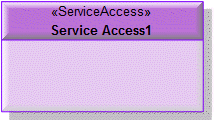Service access (UPDM - MODAF aliases)

Creation
To create a Service Access:
• From an
Architectural Description or
Service Description: right-click the Architectural Description or Service Description, point to New, point to MODAF, point to Service, and then click Service Access.
Appearance
When shown on an
SV-1 Resource Definition,
SV-4 Functionality Hierarchy,
SV-5 Function to Operational Activity/Service Function Definitionor
SV-9 Technology and Skills Forecast Definition, a Service Access appears as follows:

When shown on an
SV-1 Resource Interaction Specificationor
SV-2 Resource Communications Description, a Service Access appears as follows:

Relationships
The following relationships are of importance to a Service Access:
• UML Generalizations define Service Access inheritance (
SV-1 Resource Definition).
•
Is Capable Of Performing relationships to link a Service Access to the
Function elements that can be performed by the Service Access.
• Used as a type for
Concept Role,
Known Resource,
Node Port,
Resource Port,
Resource Role and
Service Level Value Set elements.
• Used as a conveyed classifier for
Operational Exchange elements.
The following sections provide information about how a Service Access is used in the model.
Create a Service Access from
Create from a Service Access
In addition to the UPDM elements that can be created from all UPDM elements (
Alias,
Definition,
Information and
Metadata):
Shown on these diagrams, tables and matrices
In addition to the
AV-2 Integrated Dictionary and
TV-1 Standards Profile, which can show all UPDM elements:
UPDM writeable properties
The following writeable properties are available on the Service Access tab of a Service Access element's Property Pages:
• isEncapsulated
• URI































